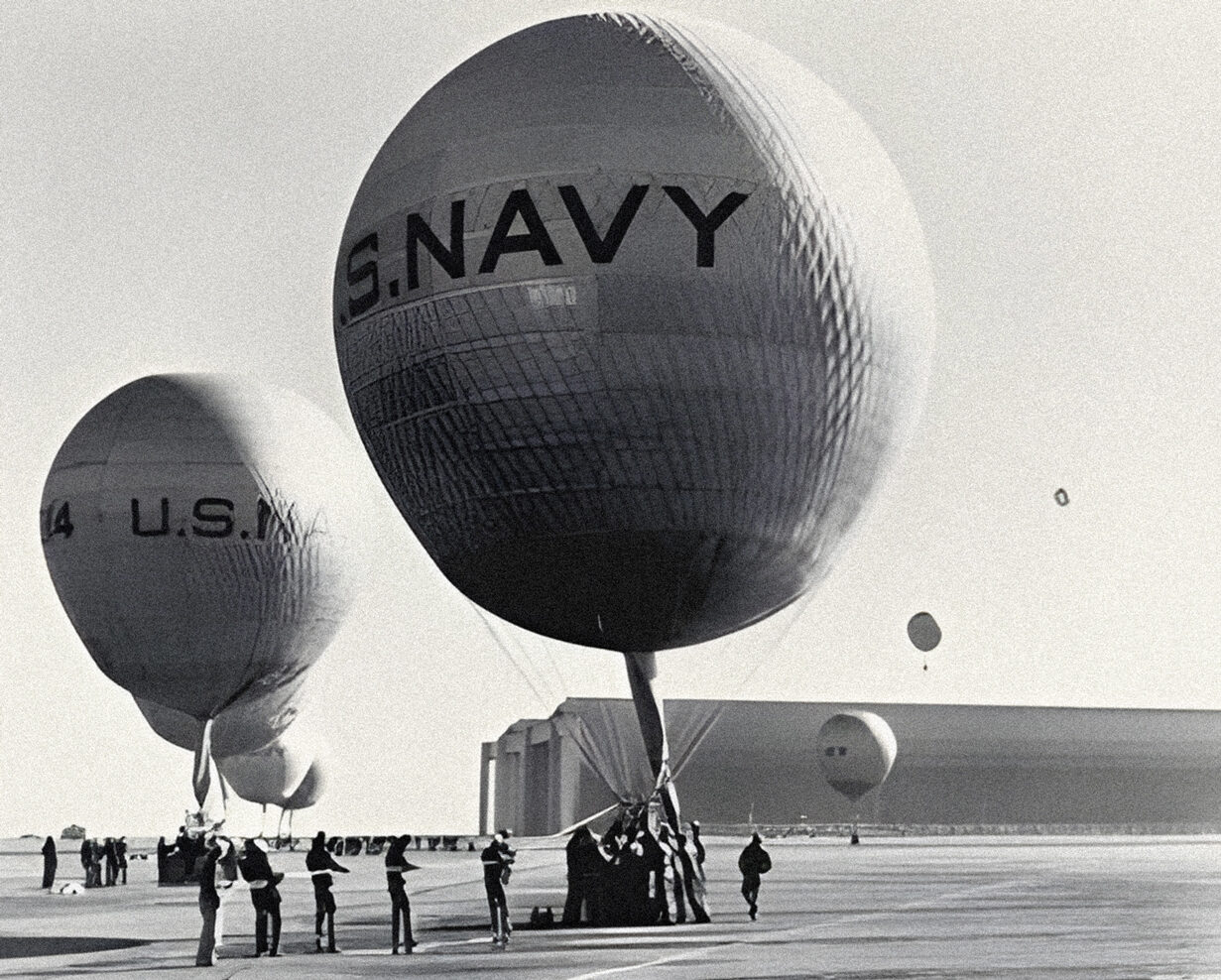VI.
Lighter-Than-Air (LTA) Era

The devastating crash of the USS Macon forced the United States government to pause the development of its lighter-than-air (LTA) program. In 1935, control of Moffett Field was transferred from the U.S. Navy to the U.S. Army Air Corps. In exchange for that property, the Navy took over the Rockwell Field Army base, located on North Island in San Diego. Moffett Field’s Hangar 1 became the home of the Army’s one non-rigid airship, or blimp, and the other aircraft that were used to train Air Corps cadets.
Faced with the mounting prospect of war, the revival of an LTA coastal patrol strategy was initiated in 1937. The Army Air Corps ended its airship program and delivered all of the elements of its LTA operations to the Navy. The attack on Pearl Harbor in 1941 kicked the Navy’s resurrected LTA plan into high-gear. Seeking out enemy submarines and mines was crucial, and an expanded fleet of blimps was considered essential to the success of those missions. However, at the beginning of World War II, the Navy had only ten airships, and from 1935 to 1942, Naval Air Station Lakehurst, New Jersey was the only LTA training and operations facility in the United States.


In 1942, the Navy regained control of Moffett Field and commissioned a new LTA scouting squadron named ZP-32. The components for the Army’s existing airships, TC-13 and TC-14, were transported via rail from Naval Air Station Lakehurst and reassembled at Moffett Field. Those blimps began monitoring the Pacific coast in February 1942. The airships were highly valued for their ability to travel long distances without refueling, cruise at slow speeds, and hover above observed targets at altitudes of 100 feet or less.
Naval Air Station Moffett Field became the headquarters for the West Coast’s Fleet Airship Wing Three, which also included LTA bases located in Tillamook, Oregon and Santa Ana, California. The Naval Airship Training Command was established at Moffett Field, and the site became the nation’s only Navy air base completely dedicated to LTA training and deployment.
The first phase of an aviation cadet’s training was learning how to fly free-drifting balloons. The exercises allowed future Naval Aviators to master essential skills such as maneuvering by valving gas, dropping ballast, and finding favorable winds and ideal altitudes that would allow the pilot to control an airship if its engine failed.


Within the newly constructed, soaring timber vaults of Hangars 2 and 3, the Assembly and Repair Department fabricated all of the original parts for new L-class airships and assembled K-class airships using components made by the Goodyear Aircraft Company.
L-class blimps were used primarily for training at Moffett Field. They were 147 feet long, nearly 40 feet in diameter, and had a volume of 123,000 cubic feet. The two-person crew airships could stay airborne for 12 hours. Two 146-horsepower Warner engines provided a cruising speed of 46 miles per hour and a range of about 2,200 miles.
K-class blimps were utilized for anti-submarine warfare (ASW). They were about 250 feet long, nearly 60 feet in diameter, and had a volume between 416,000 and 425,000 cubic feet. Nine to ten-person K-ship crews could stay aloft for approximately 40 hours and cover a range of about 2,000 miles. Two 425-horsepower Pratt & Whitney engines mounted below the control car, or gondola, produced a cruising speed of almost 60 miles per hour. The blimps were armed with four 350-pound depth charges and one or two .50 caliber machine guns.
The K-class had the largest production run of any airship type used by the U.S. Navy. Goodyear was building five K-ships a month in September 1942. Those production levels rose to 11 blimps per month by May 1943, and the company manufactured a total of 134 K-class airships by the end of World War II.




The United States was the only nation that used airships during World War II. Navy blimps monitored an area of more than three million square miles across the Atlantic and Pacific oceans and the Mediterranean Sea. Only one airship was lost in battle after it was attacked off the coast of Florida by a German submarine, known as a U-boat. U.S. blimps escorted approximately 89,000 convoy ships during the war. While traveling near the coast of New Jersey, the Panamanian oil tanker, Persephone, became the only airship protected vessel that was sunk by a German U-boat. Off the coasts of the United States, 532 ships not accompanied by blimps were destroyed by enemy submarines.
The development and implementation of new aircraft technologies made blimps obsolete. The pieces for the last K-class airship assembled at Moffett Field were delivered in January 1944. The ZP-32 squadron was decommissioned in November 1945. The Navy’s mighty LTA era at Moffett Field came to an official end in 1947. In August, the air station’s final blimp flight ended in a crash, without any casualties, off the Cape of Mendocino. The last non-rigid airship was deflated on September 3, 1947 to make way for the advanced heavier-than-air (HTA) squadrons that served at Moffett Field for the next five decades.
